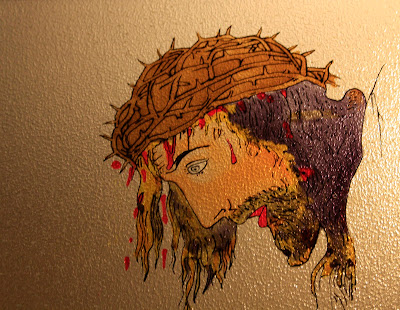Unleash the creativity from transparency
Glass painting
Glass painting is one of the more democratic of the visual arts, bridging the gap between folk and fine art. Although it has been incorporated into stained glass windows and used by prominent artists like Gainsborough and Klee, amateur artists have also practiced it.
Origin:
Gujarat was the cradle of Glass painting in India. This art painting form made its appearance in the eighteenth century. Glass painting designs and patterns comprises of engravings laid down on the back of the glass, and they are painted from the reverse.
Chinese artists who had settled in Gujarat influenced the local traditions of producing glass paintings designs also known as glass painting art. In India, painting on glass has been carried forward as a treasured legacy and today it is noted for its thematic variety, sheer brilliance, stunning clarity and use of rich colors.
 | |||
| Ancient |
Features
Glass painting is also known as "reverse glass painting," which more closely describes the technique used to produce it. With reverse glass painting, the artist is working on the back of the glass, which is the opposite of what a painter would do on canvas. He must work backwards to create the work. Facial expressions and details are painted on first, and background scenes are applied last.
Facts
Reverse glass painting differs from stained glass in several ways, although it was used in the creation of stained glass windows during the 19th century. A stained glass window is created out of pieces of glass that have been colored by the addition of powdered metals. Reverse glass painting uses clear glass as a canvas to which paints are added. Firing helps adhere the paints to the glass. Gold gilt is often used in the creation of a painted glass work. This practice is known as verre eglomise, after Jean-Baptiste Glomy, the artist who popularized the technique.
Geography
Glass painting is now practiced in countries around the world. It spread from Europe to the United States in the 18th century. In India, it emerged in the state of Gujarat around the same time. Glass painting became popular in Senegal after Muslims returning from pilgrimages to Mecca brought the technique home with them.
Function
Reverse glass painting is often associated with folk art. Religious scenes were a popular subject, as in Venetian altar decorations, or portrayals of Sufi saints created by Senegalese artists. But glass painting was also likely to reflect the daily life of the artist who created it. In addition, it was used to decorate furniture, clock faces or mirrors.
Starting in the 17th century, famous paintings were a popular topic for reverse glass art. And, according to glasspainting.co.uk, painters as well known as Thomas Gainsborough created reverse glass paintings for peep shows.
Time Frame
The origins of reverse glass painting are unknown. The Metropolitan Museum of Art places stained glass art as far back as ancient Rome, but according to glass artist Mayanne MacKay, reverse glass painting can only be traced back as far as the Renaissance, where it became fashionable in Italy.
As the supplies needed for painting on glass became scarce, artists moved to other parts of Europe, and the tradition of painting on glass spread throughout the continent. In the United States, works can be found dating from the Federal period.
The practice of glass painting has continued into the modern art tradition. Wassily Kandinsky is one artist who used glass as a medium for his paintings. Paul Klee used an unusual technique in his "Inventionen," where he painted a pane of glass white, etched in a drawing, then painted the back black to highlight the artwork.






Comments
Post a Comment